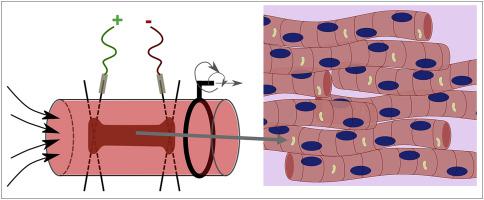Materials Today Bio ( IF 8.7 ) Pub Date : 2020-07-28 , DOI: 10.1016/j.mtbio.2020.100070 A Shahin-Shamsabadi 1 , P R Selvaganapathy 1, 2

|
Three-dimensional (3D) in vitro tissue models are superior to two-dimensional (2D) cell cultures in replicating natural physiological/pathological conditions by recreating the cellular and cell-matrix interactions more faithfully. Nevertheless, current 3D models lack either the rich multicellular environment or fail to provide appropriate biophysical stimuli both of which are required to properly recapitulate the dynamic in vivo microenvironment of tissues and organs. Here, we describe the rapid construction of multicellular, tubular tissue constructs termed Tissue-in-a-Tube using self-assembly process in tubular molds with the ability to incorporate a variety of biophysical stimuli such as electrical field, mechanical deformation, and shear force of the fluid flow. Unlike other approaches, this method is simple, requires only oxygen permeable silicone tubing that molds the tissue construct and thin stainless-steel pins inserted in it to anchor the construct and could be used to provide electrical and mechanical stimuli, simultaneously. The annular region between the tissue construct and the tubing is used for perfusion. Highly stable, macroscale, and robust constructs anchored to the pins form as a result of self-assembly of the extracellular matrix (ECM) and cells in the bioink that is filled into the tubing. We demonstrate patterning of grafts containing cell types in the constructs in axial and radial modes with clear interface and continuity between the layers. Different environmental factors affecting cell behavior such as compactness of the structure and size of the constructs can be controlled through parameters such as initial cell density, ECM content, tubing size, as well as the distance between anchor pins. Using connectors, network of tubing can be assembled to create complex macrostructured tissues (centimeters length) such as fibers that are bifurcated or columns with different axial thicknesses which can then be used as building blocks for biomimetic constructs or tissue regeneration. The method is versatile and compatible with various cell types including endothelial, epithelial, skeletal muscle cells, osteoblast cells, and neuronal cells. As an example, long mature skeletal muscle and neuronal fibers as well as bone constructs were fabricated with cellular alignment dictated by the applied electrical field. The versatility, speed, and low cost of this method is suited for widespread application in tissue engineering and regenerative medicine.
中文翻译:

Tube-in-Tube:具有集成多模式环境刺激的三维体外组织构造。
在复制自然的生理/病理状况方面,三维(3D)体外组织模型优于二维(2D)细胞培养,可以更忠实地重建细胞和细胞-基质相互作用。但是,当前的3D模型缺少丰富的多细胞环境或无法提供适当的生物物理刺激,而这两者都需要适当地概括体内动态组织和器官的微环境。在这里,我们描述了使用自组装工艺在管状模具中快速构建多细胞管状组织构造的过程,这种构造使用了能够结合各种生物物理刺激力(例如电场,机械变形和剪切力)的自组装过程流体流量。与其他方法不同,此方法很简单,仅需氧气可渗透的硅树脂管即可模制组织结构,并插入其中的细不锈钢销钉以固定该结构,并可同时用于提供电和机械刺激。组织构造和管道之间的环形区域用于灌注。高度稳定的宏观 由于细胞外基质(ECM)和填充到管中的生物墨水中的细胞的自组装,形成了锚固在销子上的坚固结构。我们展示了在轴向和径向模式下构造中包含细胞类型的移植物的图案,各层之间具有清晰的界面和连续性。可以通过诸如初始细胞密度,ECM含量,管子尺寸以及锚定销之间的距离等参数来控制影响细胞行为的不同环境因素,例如结构的紧凑性和构建体的大小。使用连接器 可以将管网组装成复杂的宏观结构组织(厘米长),例如分叉的纤维或具有不同轴向厚度的圆柱,然后用作仿生构造或组织再生的构件。该方法是通用的,并且与各种细胞类型兼容,包括内皮细胞,上皮细胞,骨骼肌细胞,成骨细胞和神经元细胞。例如,制造了成熟的骨骼肌和神经元长纤维,以及骨骼构造,并根据施加的电场确定了细胞排列。这种方法的多功能性,速度快和成本低廉,适合在组织工程和再生医学中广泛应用。骨骼肌细胞,成骨细胞和神经元细胞。例如,制造了成熟的骨骼肌和神经元长纤维,以及骨骼构造,并根据施加的电场确定了细胞排列。该方法的多功能性,速度快,成本低,适合在组织工程和再生医学中广泛应用。骨骼肌细胞,成骨细胞和神经元细胞。例如,制造了成熟的骨骼肌和神经元长纤维,以及骨骼构造,并根据施加的电场确定了细胞排列。该方法的多功能性,速度快,成本低,适合在组织工程和再生医学中广泛应用。









































 京公网安备 11010802027423号
京公网安备 11010802027423号